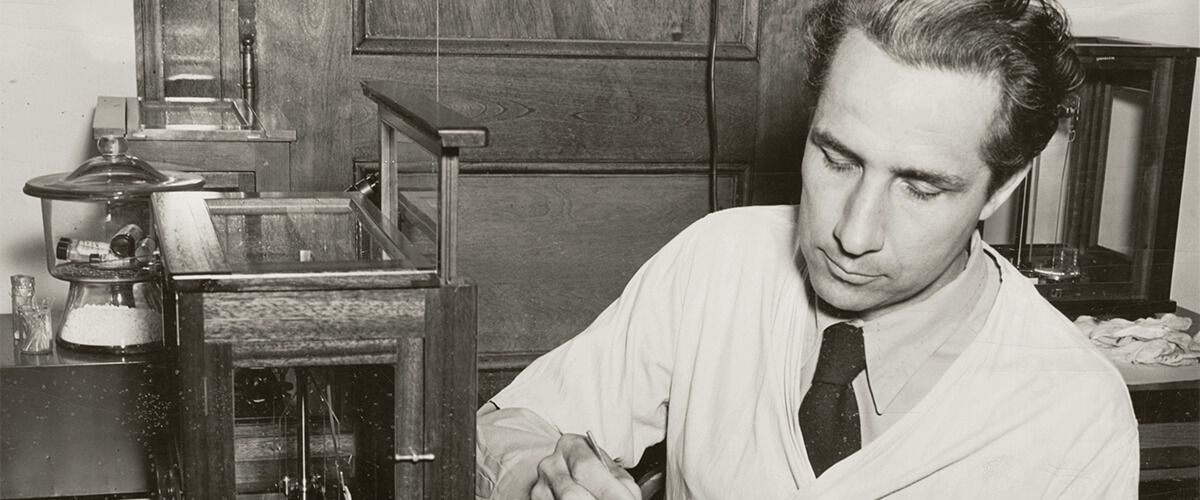It all started with a cow.
In the winter of 1933, a dairy farmer in Saint Croix County had a problem: some of his cows were dropping dead for no reason that he could discern. They ate clover, and suddenly, they would begin to hemorrhage internally. “Sweet clover disease,” as it was called, was a mystery. Many farmers took their losses and lumped it — the cause was vitamin deficiency, declared veterinarians.
The farmer, Ed Carlson, didn’t accept the verdict. He put his dead heifer in the back of his truck, along with a bucket of blood and 100 pounds of clover, and then he drove 200 miles through a blizzard to Madison to consult with his state university.
At UW–Madison, chemist Karl Paul Link 1922, MS1923, PhD1925 was also interested in sweet clover disease. He believed that the problem was chemical rather than dietary. He accepted the carcass and other materials and put the grad students in his lab to work.
What they discovered changed the world.
By 1940, Link and crew had isolated a chemical called dicoumerol, a powerful blood thinner, which they learned to synthesize in the lab. He took this to the Wisconsin Alumni Research Foundation — WARF, UW–Madison’s patent-and-licensing organization — and WARF marketed the chemical as warfarin, a rat poison, in 1948.
Did a cow from Saint Croix County make millions of dollars for Wisconsin — and save millions of lives?
It turned out that warfarin, which is tasteless and colorless, is a very good rat poison. It made a fortune for Link and the university, helping farmers to clear vermin out of their barns and homes.
But there’s more to the warfarin story than that. That cow from Saint Croix County has saved thousands — possibly millions — of lives.
In the 1940s, doctors began to take notice of warfarin’s blood-thinning qualities and started to think about how it could save lives as well as destroy them. It could, they suspected, be a boon for those at risk of stroke. In the 1950s, the first patients began taking warfarin to treat high blood pressure — and one of the first was the U.S. president, Dwight Eisenhower, who had suffered a serious heart attack in 1955.
Warfarin would become a leading treatment for blood clots and deep-vein thrombosis. But that’s not what makes it interesting. The most interesting warfarin story happened a couple of years before Eisenhower began taking it, and half a world away.
In 1953, in Moscow, the Soviet Union was preparing for another great upheaval. An increasingly paranoid Josef Stalin had become convinced that his country’s doctors — and especially Jewish doctors — were plotting to overthrow his regime by poisoning leading party officials.
The “doctors’ plot,” he let it be known, could be stopped only by another great purge — this one destroying the Soviet Union’s Jews, who then numbered about a million and a half people, many of whom had already survived the Holocaust.
The dictator’s announcements unnerved even his closest advisers. One of them, Lavrenty Beria, the head of the Soviet secret police, claims that he decided to do something about it. If his claims are true, he had his agents slip tasteless, colorless warfarin into Stalin’s food.
In 1953, Stalin died. His imagined doctors’ plot and plans for another purge fizzled.
Did Beria have Stalin poisoned with warfarin? No one knows. Beria was a spectacular sinner in his own right, and lying came naturally to him.
Stalin’s official cause of death was listed as stroke, but the autopsy showed that he’d suffered massive hemorrhage. Hemorrhage is not a symptom of stroke; it is a symptom of warfarin poisoning. Before the year was out, Beria was shot.
Did warfarin save a million and a half Soviet Jews? It’s impossible to say, but we do know that it has lengthened the lives many thousands of cardiovascular patients around the world over the last 60 years.
Thank you, Saint Croix County, for Ed Carlson and his cow, and the lifesaving discovery they brought to light.








